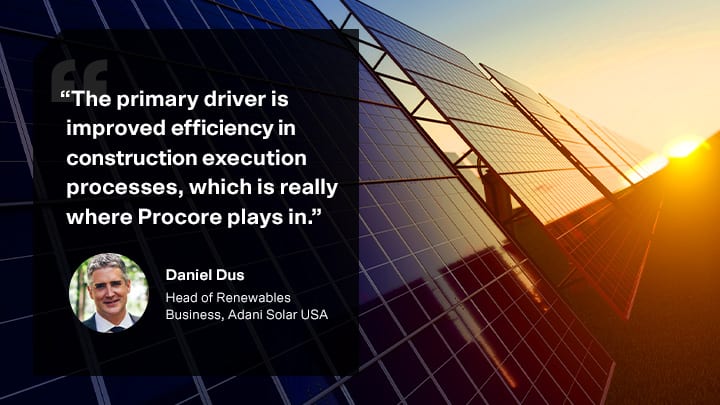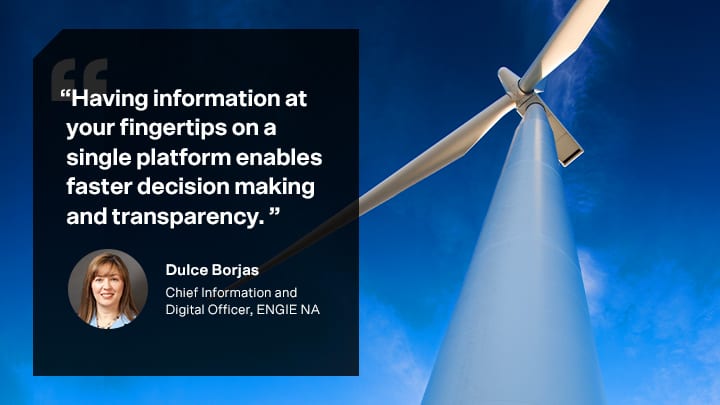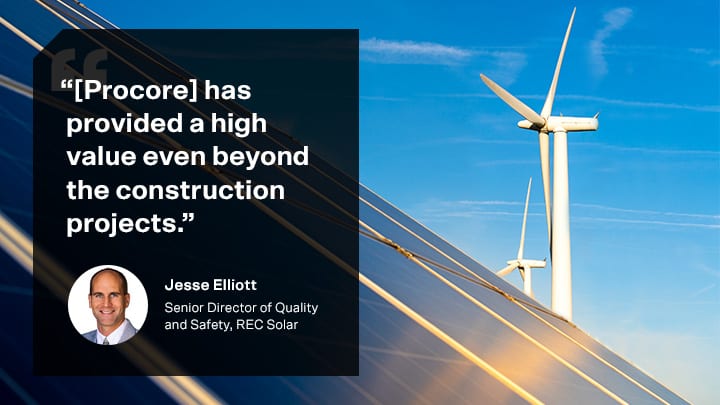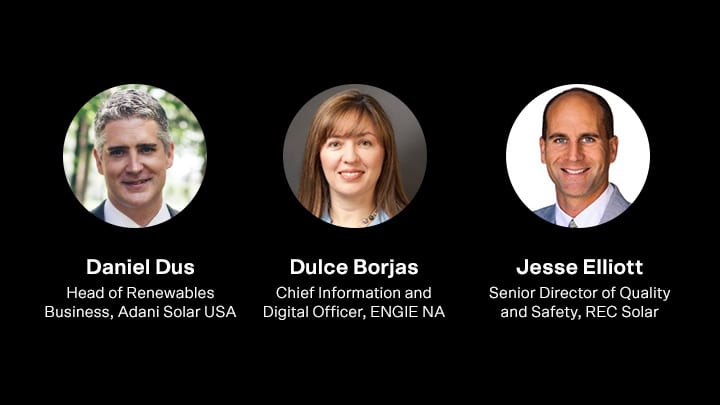Procore recently hosted a wide-ranging discussion with key team members of some of the biggest and most prominent names in renewable energy. The conversation during the webinar covered a variety of topics, with one important through line: how these billion-dollar companies, some managing hundreds of thousands of global employees and multiple concurrent projects all use Procore to make their lives easier.
The discussion was hosted by Zachary Reiss-Davis, Product and Solutions Marketing Leader, Procore. The panelists included Daniel Dus, Head of Renewables, Adani Solar USA, Dulce Borjas, Chief Information and Digital Officer, ENGIE North America, and Jesse Elliott – Senior Director of Construction, REC Solar, which is a part of Duke Energy subsidiary company.
Data Boosts the Renewable Energy Industry

The renewable energy industry is something of an outlier in that although there is fierce competition among players, they all have the same goal: helping the world transition to using green, clean energy over nonrenewable fossil fuels. Data gathering technology has been around for years now, but these days more emphasis is being placed now on how best to actually put it to work, and how the industry can come together to learn from it, rather than simply moving analog processes to a new system.
This mission aligns with Procore’s mission to connect everyone in construction on one global platform; where everyone can collaborate from a single set of analytics, tools and technologies, and a single platform from which every stakeholder can extract tangible value.
In the renewable energy space, competitive pricing and project bidding are ever-looming concerns. The panelists said Procore has been a key part of improving that process.
“We are hopefully much closer to the floor of renewable energy pricing than we were the ceiling of 10-15, years ago, when PPA prices exceeded in some cases 14 or 15 cents per kilowatt hour. We’re really approaching zero. And what’s been the primary driver historically is reduction in equipment costs, and improved efficiency in construction execution processes, which is really where Procore plays in,” said Adani Solar’s Daniel Dus.
“Procore really helps us be one of the most efficient EPCs in the country. If you look at Solar Power World’s ranking, we are number one in terms of megawatts installed per employee, and we have a staff of less than 19 folks currently in construction over 220 megawatts in the US. We’re able to do that with such a small team because we leverage third party labor providers that we fully control through the Procore system, as well as all the various stakeholders within the Procore system. So Procore allows us to drive some more efficiency in that construction process which helps us bring the cost of project execution down by being fully integrated without having to hire a third party construction manager or other services outside of our internal services,” explained Dus.
Value of Procore to Project Stakeholders: Data and Collaboration

It’s a recurring challenge in construction to get contractors on board using new technology solutions or platforms. You can always mandate a platform’s use as a condition of getting paid, but construction is a collaborative environment, so outcomes are usually better if stakeholders are enthusiastic users. That enthusiasm is easier to generate if a platform’s value is demonstrated.
ENGIE North America’s Dulce Borjas says by clearly showing Procore’s value can often make it easier to get that initial buy-in.
“For me, I think it’s showing the value of having the data and making it easier to collaborate. I think having data and information at your fingertips has only shown how important it is when you’re collaborating from the same platform and everyone’s looking at the same information that enables it,” said Borjas.
“I think showing the value that the platform brings, being able to demonstrate whether they may be getting paid more quickly or more efficiently and not just pushing information from subcontractors is one of the most important elements,” Borjas continued.
Adani Solar’s Dus also highlighted the importance of communication, noting the company even conducts special training sessions to ensure everyone not only knows how to use Procore, but can see its benefits in real time.
“There’s an education process that needs to be part of every project ramp-up for folks who are new to Procore. So our on site team will conduct training on how to use the system and demonstrate some of its benefits. It generally happens pretty quickly on site on these projects that they usually develop a pretty fraternal environment. Folks usually recognize the value very quickly,” he said.
“Human nature generally follows the path of least resistance. And so once you demonstrate that path and educate the teams…we’ve found adoption to be quite good,” he added
REC Solar’s Jesse Elliott says his company doesn’t even use every tool available in Procore, despite being prolific users of the ones they do. It’s a good example of how there’s no set path or single way the platform can help contractors.
“For a while there, we were one of the largest users of observations in your system– we use the system outside of just as a construction project management tool. We manage our facilities, fleet, and other things through your system as well. So it’s provided a high value even beyond the construction projects,” said Elliott.
Using Procore Efficiently to Save Time and Money

Adding layers of technology often brings challenges, particularly in a field like construction where change isn’t always welcomed.
Demonstrating the value of a platform like Procore can go a long way toward getting subcontractors onboard, but there’s still the uphill battle against traditional ways of thinking about the job, according to ENGIE North America’s Borjas.
“When subcontractors use the platform it works out well, but we actually still struggle with subs that actually flat-out refuse to write. They’re still stuck in the analog world. They don’t know how to make that migration to the digital space. So there’s a lot of resistance there and we sometimes have to drag them along. Which, unfortunately, creates inefficiencies that require extra oversight on our part.”
Establishing a company point-person is one way to get the most out of a platform or piece of technology.
“We have a person responsible for the platform. I think creating standards for your company, how you manage the projects, what are the key indicators that you’re going to track, and making that consistent across your projects is super important,” says REC Solar’s Elliott.
“Having that internal owner is critical, because that way you can leverage the platform consistently, and not have a project doing things differently and making it difficult if you have multiple projects reporting across that portfolio.”
Reducing Rework with Project Data Insights
The ability to view historic project data can also go a long way toward avoiding rework, and keeping everyone involved in a project working from the same, up-to-date set of project parameters.
“Historically, the transition from development and sales and origination to construction operation, in my experience, has resulted in the highest numbers of issues, failures, budget overruns, miscommunication, stress, and anxiety,” noted Dus.
“By getting data into Procore early, everyone can see the whole history of the project, because things move around early in the project life cycle. The system size can change, panel types can change, engineering of course changes. I couldn’t tell you how many times we’ve had projects go off the rails because the wrong set of plans is being used on site, especially in the analog world.”

Leave a Reply